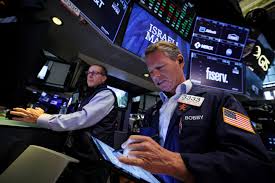On Tuesday, Wall Street saw a brief pause in its upward momentum as bond yields rose and the U.S. dollar sank to its lowest level in eight months. Investors are closely watching economic data and market signals to gauge the Federal Reserve’s next steps in its ongoing efforts to control inflation.
Key Market Movements:
- Stocks Take a Breather
After an impressive rally that has lifted markets over the past week, Wall Street took a step back. The S&P 500 remained flat, while the Dow Jones Industrial Average dipped slightly by 0.1%. The Nasdaq Composite also pulled back after a significant surge, fueled by tech stocks and investor optimism over AI advancements. - Rising Bond Yields
Bond yields climbed, with the 10-year Treasury yield rising to 4.35%, its highest level in nearly 15 years. The rise in yields reflects investors’ concerns that inflation may remain persistent, prompting the Federal Reserve to maintain higher interest rates for an extended period. This increase in yields pressured equities, particularly in interest-rate-sensitive sectors like real estate and utilities. - U.S. Dollar Hits 8-Month Low
The U.S. dollar continued to weaken, falling to an eight-month low against a basket of major currencies. The dollar’s decline is largely due to softening inflation data and rising expectations that the Fed may soon pivot away from its aggressive rate-hiking cycle. The dollar’s weakness has provided a tailwind for commodities, with gold and oil prices rising as investors seek alternatives. - Commodities Rise
Gold prices surged to $1,920 per ounce, benefiting from the declining dollar and rising inflation concerns. Meanwhile, oil prices also climbed, with West Texas Intermediate (WTI) crude reaching $82.50 per barrel, supported by supply cuts from OPEC+ and rising global demand expectations.
What’s Driving the Markets:
- Federal Reserve Watch
The key focus for investors remains the Federal Reserve’s monetary policy. With inflation data showing signs of cooling but still above the Fed’s target, there’s growing uncertainty about whether the central bank will raise rates again or hold steady at its next meeting in September. Fed Chair Jerome Powell is set to deliver a speech later this week at the Jackson Hole Symposium, where investors hope to gain further insight into the Fed’s plans. - China’s Economic Woes
China’s slowing economic growth and concerns over its property market have also been weighing on global markets. Chinese officials have taken steps to stabilize the economy, including cutting interest rates and easing lending conditions, but investors remain cautious about the potential for a more significant slowdown. - Tech Stocks and AI Buzz
Technology stocks have been a bright spot amid the uncertainty, with major players like Nvidia and Microsoft continuing to see gains. Nvidia, in particular, is expected to report strong earnings this week, driven by robust demand for AI chips, further fueling investor enthusiasm in the AI space.
Market Outlook:
- Short-Term Volatility Likely
As bond yields rise and inflation concerns persist, market volatility is expected to continue in the near term. Investors are closely watching economic data releases, such as retail sales and housing market updates, to gauge the health of the U.S. economy. - Long-Term Optimism Remains
Despite short-term uncertainty, long-term optimism remains as investors anticipate that the Fed may soon shift to a more dovish stance. Additionally, continued advancements in technology, particularly in AI, are providing a long-term growth catalyst for the market.
Investor Sentiment: While some investors are taking a cautious approach due to rising bond yields and global economic uncertainties, others remain optimistic about the potential for further stock market gains, particularly in sectors benefiting from AI innovations and a weaker dollar.



